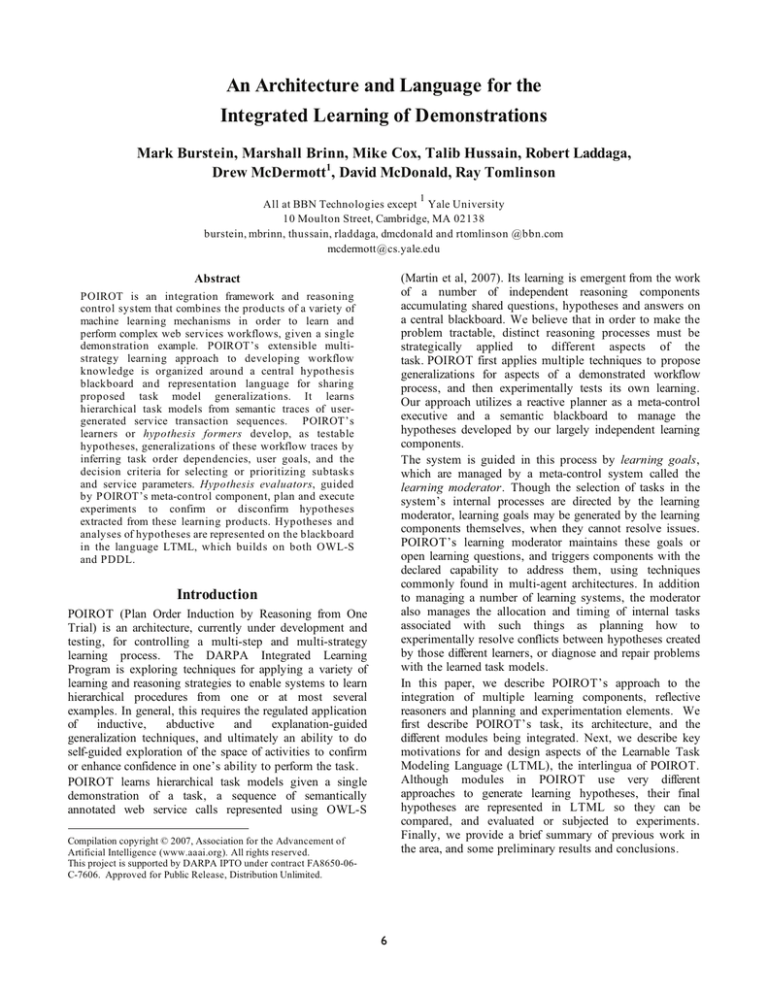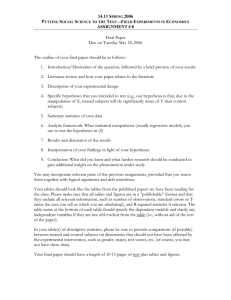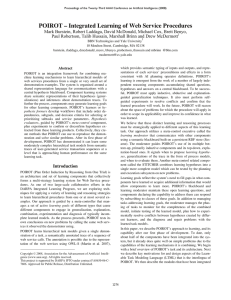
An Architecture and Language for the
Integrated Learning of Demonstrations
Mark Burstein, Marshall Brinn, Mike Cox, Talib Hussain, Robert Laddaga,
Drew McDermott1, David McDonald, Ray Tomlinson
1
All at BBN Technologies except Yale University
10 Moulton Street, Cambridge, MA 02138
burstein, mbrinn, thussain, rladdaga, dmcdonald and rtomlinson @bbn.com
mcdermott@cs.yale.edu
(Martin et al, 2007). Its learning is emergent from the work
of a number of independent reasoning components
accumulating shared questions, hypotheses and answers on
a central blackboard. We believe that in order to make the
problem tractable, distinct reasoning processes must be
strategically applied to different aspects of the
task. POIROT first applies multiple techniques to propose
generalizations for aspects of a demonstrated workflow
process, and then experimentally tests its own learning.
Our approach utilizes a reactive planner as a meta-control
executive and a semantic blackboard to manage the
hypotheses developed by our largely independent learning
components.
The system is guided in this process by learning goals,
which are managed by a meta-control system called the
learning moderator. Though the selection of tasks in the
system’s internal processes are directed by the learning
moderator, learning goals may be generated by the learning
components themselves, when they cannot resolve issues.
POIROT’s learning moderator maintains these goals or
open learning questions, and triggers components with the
declared capability to address them, using techniques
commonly found in multi-agent architectures. In addition
to managing a number of learning systems, the moderator
also manages the allocation and timing of internal tasks
associated with such things as planning how to
experimentally resolve conflicts between hypotheses created
by those different learners, or diagnose and repair problems
with the learned task models.
In this paper, we describe POIROT’s approach to the
integration of multiple learning components, reflective
reasoners and planning and experimentation elements. We
first describe POIROT’s task, its architecture, and the
different modules being integrated. Next, we describe key
motivations for and design aspects of the Learnable Task
Modeling Language (LTML), the interlingua of POIROT.
Although modules in POIROT use very different
approaches to generate learning hypotheses, their final
hypotheses are represented in LTML so they can be
compared, and evaluated or subjected to experiments.
Finally, we provide a brief summary of previous work in
the area, and some preliminary results and conclusions.
Abstract
POIROT is an integration framework and reasoning
control system that combines the products of a variety of
machine learning mechanisms in order to learn and
perform complex web services workflows, given a single
demonstration example. POIROT’s extensible multistrategy learning approach to developing workflow
knowledge is organized around a central hypothesis
blackboard and representation language for sharing
proposed task model generalizations. It learns
hierarchical task models from semantic traces of usergenerated service transaction sequences. POIROT’s
learners or hypothesis formers develop, as testable
hypotheses, generalizations of these workflow traces by
inferring task order dependencies, user goals, and the
decision criteria for selecting or prioritizing subtasks
and service parameters. Hypothesis evaluators, guided
by POIROT’s meta-control component, plan and execute
experiments to confirm or disconfirm hypotheses
extracted from these learning products. Hypotheses and
analyses of hypotheses are represented on the blackboard
in the language LTML, which builds on both OWL-S
and PDDL.
Introduction
POIROT (Plan Order Induction by Reasoning from One
Trial) is an architecture, currently under development and
testing, for controlling a multi-step and multi-strategy
learning process. The DARPA Integrated Learning
Program is exploring techniques for applying a variety of
learning and reasoning strategies to enable systems to learn
hierarchical procedures from one or at most several
examples. In general, this requires the regulated application
of
inductive,
abductive
and
explanation-guided
generalization techniques, and ultimately an ability to do
self-guided exploration of the space of activities to confirm
or enhance confidence in one’s ability to perform the task.
POIROT learns hierarchical task models given a single
demonstration of a task, a sequence of semantically
annotated web service calls represented using OWL-S
Compilation copyright © 2007, Association for the Advancement of
Artificial Intelligence (www.aaai.org). All rights reserved.
This project is supported by DARPA IPTO under contract FA8650-06C-7606. Approved for Public Release, Distribution Unlimited.
6
formers use bottom up (inductive) and top down (abductive
or explanation-based) generalization techniques to produce
hypotheses that are posted on the hypothesis blackboard.
The learning moderator communicates about internal
system tasks and learning goals with the other modules
using a simple handshake protocol, and receives task status
feedback through the same blackboard, but using a slightly
different API that permits updates to transient facts about
status and more control over component activation than the
pub-sub mechanism used by other modules.
Overview of Learning Task
POIROT’s objective is to form a generalized hierarchical
task model from ‘observed’ semantic traces of sequences of
web service transactions. The domain we are currently
using for our investigation is medical evacuation airlift
planning, and our model is analogous to the use of web
services for trip planning, where one uses different web
sites to books airline tickets, reserves local transportation
(e.g., taxis, trains buses) and hotel rooms. Differences from
these commercial procedures when planning medical
evacuations include the ability to reserve aircraft for flights
outside normal schedules, the use of helicopters and
ambulances rather than trains and taxis, and the reservation
of hospital beds rather than hotel rooms. A typical
demonstration used as the basis for POIROT’s learning
shows a number of patients being scheduled to be moved
to suitable hospitals, and may also deal with some of the
special cases that crop up, such as needing to make sure
the patient is accompanied by appropriate medical
personnel and equipment.
POIROT’s observations are of a sequence of calls to web
services that perform tasks such as looking up airports by
geographic location, finding available flights to and from
those airports, reserving seats on flights and reserving
hospital beds at the destinations. Figure 1 shows the GUI
used by people to call these services and thereby
demonstrate the task. A demonstration given to the human
subjects we are comparing our performance to shows how
each service is selected, its parameters filled in, and the
request submitted.
Invoke “Lookup Flight ” service
and enter the parameters (from,
to, earliest, latest) and hit OK.
Figure 2: POIROT Architecture
Learning and Reasoning Technologies
In this section we describe a subset of the reasoning
approaches that POIROT will ultimately integrate,
focusing on ones that we are currently using during this
phase of the research. Our overall learning framework is
based in part on the concept of goal-driven learning,
described previously (Hunter 1989, 1990, Ram & Hunter,
1992, Cox & Ram, 1994, desJardins, 1995) as
‘knowledge acquisition planning’ or ‘planning to learn’.
Goal-driven learning leads to targeted searches for
explanations when observations don’t fit into the
developing model, and to the creation of new knowledge
goals about the availability of choices and decision
processes associated with task elaboration. POIROT also
uses more traditional bottom up approaches that generalize
the given observations, using some background knowledge
to guide the degree of generalization. We describe the latter
first, and then discuss the role of explanation-based method
in forming hierarchical task models.
A compatible existing
flight was found!
Figure 1: POIROT GUI
Integration by Multi-agent Blackboard
Architecture
POIROT’s software framework uses a combination of agent
and semantic web service architectural elements to integrate
multiple learning and execution components as shown in
Figure 2. The central hypothesis blackboard where learning
hypotheses and commentary are exchanged is built on a
persistent RDF store (Sesame), extended to support
context-bounded queries and a publish-subscribe interface
that is used to wake up POIROT components. Hypothesis
Task Structure Determination
In this, the first year of the project, we have relied
primarily on two learning systems for basic task structure
determination, each directly generalizing on the observed
trace. Both techniques utilize the dependencies between
information gathering actions (data querying services) and
information consuming ones (when service parameters are
7
filled in) as a means of inferring dependencies between
actions (service calls).
WIT (from UMBC) is based on their prior work on
context-free grammar induction (Oates et al, 2002; Yaman
and Oates 2007). The demonstration POIROT observes is
treated as containing a small set of examples of service call
sequences, each handling (that is, scheduling for transit)
one of the specified patients. WIT uses these as its set of
positive training examples to produce essentially a finite
state model of the transitions between steps. While this
model can serve as a recognizer for acceptable workflows, it
cannot by itself be used to plan one, as it does not model
the choices that must be made at branch points.
A second hypothesis former utilizes and extends the work
of Winner and Veloso (2002, 2003). This system,
DISTILL, automatically learns problem-specific universal
procedures from demonstrated examples. DISTILL
produces workflow methods that loop over loosely ordered
steps that are runtime conditionalized. It develops these
conditions by a causal analysis of the actions in the
demonstration. Both WIT and DISTILL post their
solutions as LTML representations of hypotheses about
suitable subtask methods generalized from the trace.
applying additional background knowledge to explain their
relevance. Explanations are produced by inferring
relationships between steps using explanatory schemas that
tie the steps to the domain goals of the demonstrator.
POIROT’s Explanation of Intent Hypothesis Former is
based on Meta-AQUA (Cox, 1996; Cox & Ram, 1999), a
goal-driven explanation and learning system that has the
top level goal to understand each observation in its input
stream. It relies on domain knowledge, a case library of
prior plan schemas and a set of general explanation patterns
that are used to characterize useful explanations involving
that background knowledge.
POIROT relies on Meta-Aqua to explain steps that do not
have strong observable connection to other steps in the
demonstration. For example, steps that gather information
used to confirm a precondition for another step, when that
precondition is not otherwise known to be required to
perform the step in general. If the rationale for the
precondition can be plausibly explained by analogy to a
historical example and/or by reference to the user’s goals,
then that explanation justifies the insertion of an ordering
constraint into the temporal network of steps represented in
the generalized workflow for that context.
Meta-Aqua is also used to associate high level
demonstrator goals with observed demonstrator actions.
This, independent of local causal relations, helps sets of
intentionally related steps to be organized into loosely
coupled hierarchical methods.
Hierarchical Structure Determination
The LIGHT Hypothesis Former builds on prior work by
Langley and his colleagues on the problem of learning of
hierarchical task networks from traces of successful
problem-solving (e.g., Choi & Langley, 2005) or from
observations.
The
method
learns
hierarchical
representations of planning knowledge similar to that in
Nau et al.'s (1999) SHOP2 planning system. It builds sets
of methods that together can be used to accomplish the
demonstrated task. Methods are encoded with a head (goal
state), an ordered set of subtasks, and a set of conditions
under which the method should be considered. LIGHT’s
learning method determines the hierarchical problem
decomposition by back-chaining through the activity and
observation sequence (a semilattice in which each subplan
has a single root node) to form a hierarchical structure that
suggests a general method for each subgoal. It indexes
methods for subgoals by the goal literals they achieve.
Where appropriate, the resulting structures include
disjunctive and recursive methods, substantially reducing
the time required to solve novel problems, even for
problems larger than the training example.
POIROT uses LIGHT as a means of identifying subtasks
that be separated out from the overall activity sequence
represented by the demonstration trace.
Using ILP to learn loop ordering criteria
The class of tasks POIROT learns is intrinsically
repetitive. Many patients must be scheduled, using limited
resources. This leads to choices about priorities that appear
in the workflow as choices about such things as the order
in which patients are considered for transit. Critical
patients are given first crack at being scheduled so that they
arrive at their destination in the shortest period of time.
When POIROT recognizes that the procedure involves
satisfying a repetitive goal – scheduling a set of patients for
transit, and learns a procedure for scheduling one patient, it
is ready to address the learning goals associated with
learning repetitive, resource-bounded processes. One of
these is the question of how (or whether) to impose a
particular order on the satisfaction of the conjuncts of this
top level goal. While this could be based on an attempt to
explain the priorities of the demonstrator, in general there
won’t be enough information available to do this directly.
This issue has been addressed by Jude Shavlik’s group at
the University of Wisconsin, who have developed a
Hypothesis Formation module (DRILL) using inductive
logic programming techniques based on (Goadlich et al,
2004) to learn logical predicates describing the relative
ordering relationships among elements of the set of goal
objects (i.e., the patients) that aligns with the order in
which the those objects were observed to be processed
(patients scheduled), and is inconsistent with other
orderings. This module will, in general, be triggered when
Explanation-Based Composition of Activities
POIROT can be viewed in part as processing a stream of
observations to explain how they form a coherent whole.
While bottom-up hypotheses formers identify regularities
in a demonstrated workflow, aspects of the workflow that
are not repeated and do not have observable causal support
are more difficult to generalize in a useful way without
8
the meta-control system identifies that there is postulated
loop over a set of unordered objects, and it is able to gather
as examples the observed order the objects were considered
in during the demonstration.
need for referential modularity required breaking down
these task models into sets of assertions internally, and we
were able to do this adequately using OWL description
logic formalisms, with some additional devices for
circumscribing contexts and referencing portions of named
descriptions. Figure 3 shows a sample method definition.
Note that includes a step referencing the example from
which it was generalized.
The Learnable Task Modeling Language
The modularity of our architecture depends on an ability to
share hypotheses and conclusions using descriptions on the
hypothesis blackboard. A group led by Drew McDermott,
Mark Burstein and Robert Goldman has developed a
language for representing the accumulated hypotheses about
generalizations of the observed task. called the Learnable
Task Modeling Language (LTML) LTML is based in part
on the PDDL planning language (McDermott et al, 2000),
and OWL-S, but also includes a simple s-expression
syntax for RDF descriptions, and the whole language fully
translates into OWL/RDF for storage on the POIROT
blackboard. LTML is used to represent planning methods,
plans, observations or traces, and domain concepts. It is
also used to capture hypothesis annotation information,
including such as things as provenance (which learning
system proposed it) conflicts between hypotheses,
explanations and learning goals.
A central issue in an integrated learning system is the
representation of hypotheses. As our focus is on learning
process workflows, hypotheses must describe the
intentions and procedures learned from the human
demonstrator. Workflow methods describe such things as
the information passed from one action (step) to another,
state effects, action conditions, resources (informational
resources, permissions, etc.), and ultimately, certainty of
conditional outcomes and measures of utility of methods
for achieving goals.
Our current draft of LTML satisfies a number of sometimes
competing requirements. It had to be capable of describing
hierarchical task methods in a way that was acceptable to
HTN planners such as SHOP2. It had to do so in a way
that allowed arbitrary fragments of such descriptions to be
independently derived or referenced, so that they could be
annotated as hypotheses. It had to support descriptions of
relationships among hypotheses, such as conflicts or
congruences, and support capturing of explanations or
justifications for hypotheses. It also had to support internal
learning goals and task descriptions that made reference to
hypotheses as objects of the discourse.
Thus, for learning and hypothesis formation, LTML
needed to enable modular chunks of information to be
added, annotated and contradicted by different reasoners. It
must be easy to keep track of a family of related but
competing hypotheses, and to circumscribe a set of
consistent hypotheses so that they may be tested together
by construction of an experiment. In contrast, many
planners represent plans and actions as single compound
expressions which lack these modularity properties. For
example, the SHOP hierarchical planner assumes a plan
library of methods, each of which is written in a specialpurpose notation specifying steps and their orderings. Our
(Method WIT@Method0
(body
(seq seq0 (links v0 - Set)
(acts
(perform step0
(med@lookupRequirements )
(put (med@lur_out => v0))
(occurrence TraceElt1))
(loop step1
(links (v1 (over v0)))
(body
(perform step2 (Method1 (in <= v1))))))) )
Figure 3: Small LTML fragment
Hypotheses and Experimentation
POIROT also includes an Experimental Design module
(CMAX) being developed by Paul Cohen and Clay
Morrison at USC/ISI. This module will identify and plan
how to explore unresolved causal constraint questions in
its target domain of learning. The causal hypothesis
generator in CMAX explores which likely causes are
simultaneous or otherwise coincidental changes of state; for
example, it considers when knowledge revealed by one
event is utilized (directly or indirectly using the results of
further inference) in a later task; as well as extant but
general causal models.
The causal hypothesis evaluator plans simple confirmatory
and disconfirmatory experiments to refine the scope of such
hypotheses. Causal conditions and other task structure
hypotheses are tested by the execution of experiments that
systematically vary the demonstration trace to establish the
conditions under which an action to test the hypotheses
can be performed. Typically this will involve manipulating
conditions in the simulated environment provided by the
set of available web services.
This hypothesize and test approach provides a domain
grounded means to compare and contrast disparate
hypotheses about task methods. The results of these
experiments can be used to select one hypotheses over
another, or to produce new hypotheses that refine the
models suggested by others.
Using an HTN Plann er for Experimentation
POIROT tests what it has learned by selecting sets of task
achievement methods that together should be sufficient to
enable an HTN Planner to reenact the demonstration or to
perform other suitably similar tasks. The SHOP2 Planner
has been incorporated into POIROT by Robert Goldman at
SIFT Technologies and Dana Nau at the University of
Maryland. It interprets LTML descriptions of HTN
9
planning domains and problems, develops executable task
plans, and executes them using a runtime module called
SHOPPER. SHOPPER in turn invokes domain web
services through calls to the OWL-S virtual machine
(OVM), developed by Katia Sycara’s group at CMU
Robotics Institute (Paolucci et al, 2003).
This experimental execution module enables POIROT to
develop and execute plans to evaluate its shared task
models, and provide feedback on the quality of those
execution results. The use of semantic web services
described using OWL-S both provides the learners with
declarative models of the primitive actions of the domain
being observed, and enables the system (through the
OVM) to perform experiments by actually calling the
demonstrated services, even though they were not known
to the system beforehand.
reliance on background knowledge and addressing richly
structured parallel repetition.
Our learning of task hierarchies is related to methods for
learning macro-operators (e.g., Iba, 1988; Mooney, 1989),
in that they explicitly specify the order in which to apply
operators, but they do not typically support recursive
references. Recent learning work in programming by
demonstration such as (Lau, 2001) is also related to our
approach. Here, text editor macros are learned by reasoning
about how to generalize examples using version space
algebras.
Preliminary Results and Conclusions
The POIROT Project is just completing the first of several
year-long phases of development. During each phase, our
approach is being tested by comparison with the
performance of a pool of human subjects given similar
background information and practice with a web services
interface. For this phase we tested 40 subjects using a
demonstration of scheduling four patients that took 41
service calls and 116 parameter assignments. Using
automated scoring rules, subjects average about 87%
correct in choices of service calls and parameter
assignments, but get only about 55% of the right answers.
Our preliminary tests with POIROT, combining results
from WIT and DISTILL primarily, get very similar
results.
These results are preliminary in several important respects.
We have not incorporated some of the modules that will
induce a stronger hierarchical and goal-directed structure to
the learned model (e.g., LIGHT), or detailed preference
criteria (DRILL), and so our scoring criteria have not been
extended to capture errors due to those factors. We have
also not scored the system on a suite of problems that
systematically explores the space. More thorough
experimental results will be presented at the workshop.
The overall objective of the POIROT project is the
development of an architecture that draws on and combines
the strengths of a collection of machine learning approaches
to solve the difficult problem of learning complex
procedural models from a single demonstration. To date,
we have been primarily focused on infrastructure
development required to support the suite of learning
components that will ultimately be part of POIROT. Over
the course of the next year, we will be addressing a number
of issues relating to the control and coordination of these
various learning and reasoning elements, and explicit
modeling of the level of certainty of the alternative
hypotheses that they produce.
Related Work
Investigation of multi-strategy reasoning and learning
systems can be traced as far back as to the Pandemonium
system (Selfridge, 1959) that combined multiple
competing pattern recognition methods. Similarly the area
of multi-strategy learning (Michalski & Tecuci, 1994)
seeks to organize and taxonomize the various learning
methods and to develop procedures whereby multiple
learning algorithms can be effectively combined.
Michalski's (1994) Inferential Theory of Learning provides
a fundamental taxonomy of learning methods that includes
inductive, deductive, and analogical algorithms.
Furthermore the general idea of a learning goal was
established here. In Michalski's view the default learning
goal is to increase the total knowledge of the system,
though he did not refine the notion.
A large body of work has focused on acquiring and using
domain knowledge to reduce planning search. Some of the
most commonly used forms of learning for planning
include control rules, e.g., (Minton, 1988); case-based and
analogical reasoning, e.g., (Kambhampati & Hendler,
1992; Veloso, 1992); and hierarchical and skeletal
planning (Knoblock, 1994; Korf, 1985). Many of these
methods suffer from the utility problem, in which learning
more information can actually be counterproductive because
of difficulty with storage and management of the
information and with determining which information to use
to solve a particular problem.
Other work has focused on analyzing example plans to
reveal a strategy for planning in a particular domain. One
example of this approach is Shavlik's algorithm
BAGGER2 (Shavlik, 1990), which uses example solutions
and domains and background knowledge in the form of
recurrences to learn an algorithm for problem-solving also
in the form of recurrences. BAGGER2 was able to learn
such algorithms from very few examples, but relied on
background knowledge and was unable to identify parallel
repetition steps in a transport-domain problem. DISTILL
can be seen as an extension of this work but with no
Acknowledgements
We gratefully acknowledge other members of the POIROT
team: Paul Cohen, Marie desJardins, Chris Geib, Yolanda
Gil, Robert Goldman, Karen Haigh, Pat Langley, Michael
Littman, Steve Minton, Tom Mitchell, Karen Myers,
Dana Nau, Tim Oates, Jude Shavlik, Katia Sycara,
10
Manuela Veloso and their local staffs for
discussions and contributions to this effort. We
the rest of the BBN team including: Michael
Brett Benyo, Karen Haigh, Alice Mulvehill,
Ostwald for all of their work.
numerous
also thank
Atigetchi,
and John
Lau, T. (2001). Programming by demonstration: a machine
learning approach. Doctoral dissertation, University
ofWashington, Seattle.
Kambhampati, S., & Hendler, J. A. (1992). A validation
structure based theory of plan modification and reuse.
Artificial Intelligence, 55, 193-258.
David Martin, Mark Burstein, Drew McDermott, Sheila
McIlRaith, Massimo Paolucci, Katia Sycara, Deborah L.
McGuiness, Evren Sirin, Naveen Srinivasan, "Bringing
Semantics to Web Services with OWL-S" W W W Journal
(Forthcoming, 2007)
Melville, P. and Mooney, R.J. (2004). “Diverse ensembles for
active learning,” Proceedings of the Twenty-First
International Conference on Machine Learning, Banff, AB,
Canada, p. 584—591.
Michalski, R. S. (1994). “Inferential theory of learning:
Developing foundations for multistrategy learning,” in R. S.
Michalski & G. Tecuci (Eds.), Machine learning IV: A
multistrategy approach (pp. 3-61). San Francisco: Morgan
Kaufmann.
Michalski, R. S. & Tecuci, G. (Eds.) (1994). Machine
Learning: A multistrategy approach IV. San Mateo, CA:
Morgan Kaufmann.
Mooney, Raymond J.: The Effect of Rule Use on the Utility of
Explanation-Based Learning. IJCAI 1989: 725-730
Nau, D., Cao, Y., Lotem, A., & Munoz-Avila, H. (1999).
“SHOP: Simple hierarchical ordered planner,” Proceedings of
the Sixteenth International Joint Conference on Artificial
Intelligence (pp. 968-973). Stockholm: Morgan Kaufmann.
Paolucci, M, Ankolekar, A., Srinivasan, N., Sycara, K, (2003)
“The DAML-S Virtual Machine, “ Proceedings of the Second
International Semantic Web conference (ISWC 2003). Sanibel
Island, FL.
Ram, A., and Leake, D. (Eds.), Goal-Driven Learning (pp.
421-437). Cambridge, MA: MIT Press/Bradford Books.
Salomaki, B., Nejati, N., Choi, D., & Langley, P. (in press).
“ Learning teleoreactive logic programs from observations,”
Proceedings of the 2005 AAAI Fall Symposium on MixedInitiative Planning. AAAI Press.
Selfridge, O. G. (1959). “Pandemonium: A paradigm for
learning,” in D. V. Blake and A. M. Uttley (Eds.), Proceedings
of the Symposium on Mechanisation of Thought Processes
(pp. 511-529), London: H. M. Stationary Office.
Shavlik, Jude W. (1990) “Acquiring recursive and iterative
concepts with explanation based learning,” Machine
Learning, 5, p. 39–70.
Veloso, M. M. (1992). Learning by analogical reasoning in
general problem solving. Doctoral dissertation, School of
Computer Science, CMU, Pittsburgh, PA.
F. Yaman and Tim Oates. WIT: Workflow Inference from Traces,
AAAI 2007 Workshop on Acquiring Planning Knowledge
via Demonstration.
References
Burstein, M.H. (2004). “Dynamic Invocation of Semantic Web
Services that Use Unfamiliar Ontologies,” IEEE Intelligent
Systems, 19(4), p. 67-73.
Burstein, M., Bussler, C., Finin, T., Huhns, M., Paolucci, M.,
Sheth, A., Williams, S. and Zaremba, M. (2005). “A Semantic
Web Services Architecture,” IEEE Internet Computing,
September-October.
Choi, D., & Langley, P. (2005). “Learning teleoreactive logic
programs from problem solving,” Proceedings of the Fifteenth
International Conference on Inductive Logic Programming
(pp. 51-68). Bonn, Germany: Springer.
Cohn, D., Atlas, L. and Ladner, R. (1994). “Improving
Generalization with Active Learning,” Machine Learning,
15(2), p. 201-221.
Cox, M. T. (1997). “Loose coupling of failure explanation and
repair: Using learning goals to sequence learning methods,”
in D. B. Leake & E. Plaza (Eds.), Case-Based Reasoning
Research
and
Development:
Second
International
Conference on Case-Based Reasoning (pp. 425-434). Berlin:
Springer-Verlag.
Cox, M. T., & Ram, A. (1999). “Introspective multistrategy
learning: On the construction of learning strategies,”
Artificial Intelligence, 112, 1-55
Cox, M. T., & Ram, A. (1995). “Interacting learning-goals:
Treating learning as a planning task,” in J.-P. Haton, M. Keane
& M. Manago (Eds.), Advances in case-based reasoning (pp.
60-74). Berlin: Springer-Verlag.
desJardins, M. (1995). “Goal-directed learning: A decisiontheoretic model for deciding what next to learn,” in A. Ram &
D. Leake (eds.), Goal-Driven Learning. Cambridge, MA: MIT
Press/Bradford Books, pp. 241-249.
Geib, C. W. and Goldman, R. P. Recognizing plan/goal
abandonment. In Proceedings of IJCAI 2003, 2003.
M. Goadrich, L. Oliphant , and J. Shavlik (2004). Learning
ensembles of first-order clauses for recall-precision curves.
Proc. 14th Intl. Conf. on Inductive Logic Programming (ILP),
Porto, Portugal. (Best-paper award winner.)
Hunter, L. E. (1990b). “P lanning to learn,” Proceedings of
Twelfth Annual Conference of the Cognitive Science Society.
Hillsdale, NJ: Lawrence Erlbaum Associates, pp. 261-276.
Iba, Glenn, A Heuristic Approach to the Discovery of MacroOperators. Machine Learning, 3(4):285-317, 1989.
Craig A. Knoblock. Automatically Generating Abstractions
for Planning. Artificial Intelligence, 68 (2):243-302, 1994.
R. Korf. Macro-Operators: A Weak Method for Learning.
Artificial Intelligence, 26 (1):35-77, 1985.
11







